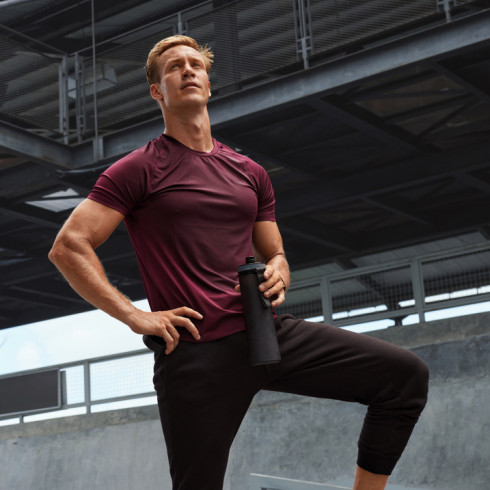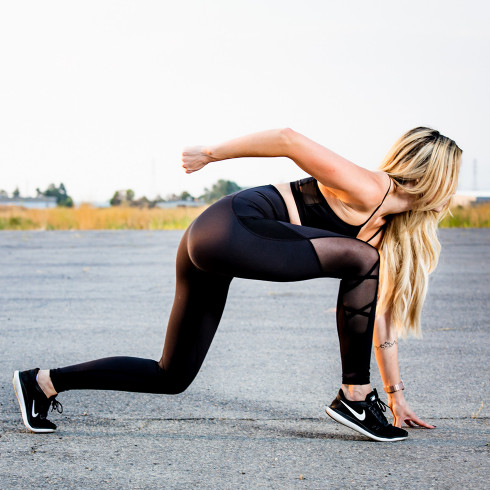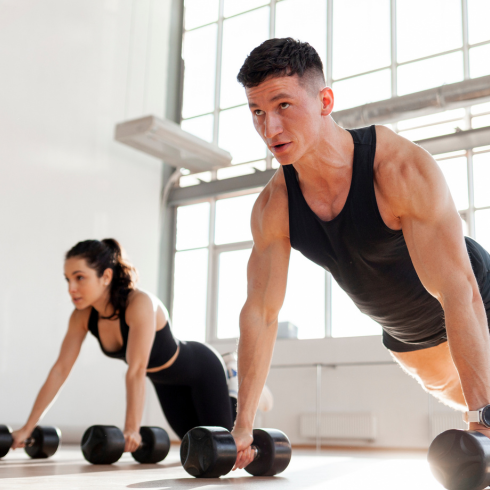The 7 Best Exercises for Sculpted Biceps
TABLE OF CONTENTS
- Biceps Anatomy
- Muscles Associated with the Biceps
- Main Functions of the Biceps
- How to Train Your Biceps Properly?
- Mistakes to Avoid for Optimal Progress
- The 7 Best Exercises for Sculpted Biceps
- How to Work the Biceps Without Equipment
- Biceps Training Frequency
- Mistakes to Avoid During Biceps Training
- Coach’s Tips
BICEPS ANATOMy:
The biceps brachii is a muscle located on the anterior part of the arm. It consists of two muscle heads:
- The long head:
- It originates above the shoulder joint (supraglenoid tubercle of the scapula) and descends along the arm.
- The short head:
- It attaches to the coracoid process of the scapula and joins the long head to form the body of the biceps.
These two heads join to insert on the tuberosity of the radius and the biceps aponeurosis.
MUSCLES ASSOCIATED WITH THE BICEPS
The biceps never works alone! Other muscles assist in arm movements:
- The anterior brachial: Located under the biceps, it is essential for elbow flexion.
- The brachioradialis: A forearm muscle that also plays a role in elbow flexion.
- The triceps brachii: The antagonist of the biceps, it is responsible for arm extension.
FONCTIONS PRINCIPALES DU BICEPS
The biceps brachii plays several roles in the mobility and stability of the arm:
- Elbow flexion: It allows bending the forearm towards the shoulder.
- Forearm supination: It helps turn the palm of the hand upwards.
- Shoulder stabilization: Particularly through the long head, which helps keep the humerus in place.
These functions explain why the biceps is activated in many daily movements, whether it’s lifting a load or simply turning a key.
HOW TO TRAIN YOUR BICEPS PROPERLY
Key Principles to Maximize Biceps Development
- Vary the exercises: Each exercise targets muscle fibers differently.
- Control the movement: Avoid swinging to maximize muscle contraction.
- Optimize load and volume: Train with 8 to 12 repetitions for hypertrophy, and 5 to 8 repetitions for strength.
- Include appropriate rest periods: About 45 to 60 seconds between sets for hypertrophy, and 90 seconds for strength.
MISTAKES TO AVOID FOR OPTIMAL PROGRESS
Using too heavy a load: This reduces the range of motion and engages other muscles (shoulders, back).
- Neglecting the eccentric phase: Slowing down the lowering of the weight maximizes tension on the muscle.
- Having poor posture: A curved back or elbows that move too much can limit biceps activation.
The biceps is an essential muscle for arm strength and aesthetics, but its training should not be neglected in favor of other muscles like the triceps and forearm. A varied approach, with targeted exercises and proper control of movement, helps maximize its development and prevent injuries.
Whether it's to improve your strength, endurance, or simply the aesthetic look of your arms, a structured and smart training routine will guarantee lasting results!
THE 7 BEST EXERCISES FOR SCULPTED BICEPS
Barbell Curl
This basic exercise engages the entire biceps. Stand and hold a straight bar with a supinated grip (palms up), hands shoulder-width apart. Bend your elbows to bring the bar towards your shoulders, then lower it slowly.
Dumbbell Curl
Dumbbells allow unilateral work, helping to correct imbalances between the arms. Stand, holding a dumbbell in each hand, arms by your sides, palms facing inward (neutral grip). Flex one elbow while rotating the wrist so the palm faces upwards (supination) at the top of the movement. Alternate or do both arms simultaneously.
Incline Curl
The incline dumbbell curl is an effective exercise to target the long head of the biceps by stretching it further.
- 1. Setup: Adjust a bench to a 45-degree incline and sit, with your back firmly pressed against the backrest. Hold a dumbbell in each hand with a supinated grip (palms up), arms hanging by your sides.
- 2. Execution: Without moving your shoulders, bend your elbows to bring the dumbbells towards your shoulders, contracting your biceps.
- 3. Descent: Slowly lower the dumbbells back to the starting position, controlling the movement to maximize the effectiveness of the exercise.
Concentration Curl
The concentration curl is an effective exercise for isolating and strengthening the biceps.
- 1. Starting position: Sit on a bench, feet apart, and lean your torso slightly forward. Hold a dumbbell in one hand, arm extended toward the floor, with your elbow resting against the inside of your corresponding thigh.
- 2. Movement: Without moving your shoulder, flex your elbow to bring the dumbbell toward your shoulder, contracting the biceps strongly.
- 3. Return: Slowly lower the dumbbell back to the starting position, controlling the movement to maximize the effectiveness of the exercise.
Preacher Curl (Larry Scott Curl)
The preacher curl, also known as the Larry Scott curl, is an exercise that specifically targets the biceps by minimizing the involvement of the shoulders and back.
- 1. Positioning: Sit on the preacher curl bench, adjusting the seat so your armpits are firmly pressed against the curve of the bench, which is inclined at about a 45-degree angle. Hold a barbell with a supinated grip (palms up), arms extended but with a slight bend in the elbows.
- 2. Execution: Inhale and flex your elbows to bring the barbell toward your chest, keeping your arms in contact with the bench and contracting the biceps.
- 3. Return: Exhale while slowly lowering the barbell back to the starting position, controlling the movement and avoiding fully extending your arms.
Hammer Curl
This variation targets the brachialis and brachioradialis. Stand and hold a dumbbell in each hand, palms facing your body (neutral grip). Bend your elbows to bring the dumbbells towards your shoulders without altering the position of your wrists.
Supine Pull-ups (Chin-ups)
This compound exercise effectively engages both the biceps and the back. Grab a pull-up bar with a supinated grip, hands shoulder-width apart. Perform a pull-up toward the bar until your chin passes over it, then lower yourself in a controlled manner.
Incorporating these exercises into your training routine will help you develop strong and aesthetically balanced biceps. Be sure to execute each movement with proper technique to maximize benefits and prevent injuries.
HOW TO WORK THE BICEPS WITHOUT EQUIPMENT?
It is entirely possible to strengthen and sculpt your biceps without using specific equipment. By using your body weight and everyday objects, you can perform effective exercises to develop your arms. Here is a selection of exercises to integrate into your routine:
- 1. Close-Grip Push-ups (Diamond Push-ups)
This exercise intensely targets the triceps, chest, and biceps. By bringing your hands closer under your chest, you increase the engagement of the biceps.
Starting position: Get into a plank position, hands close together to form a diamond shape under your chest, legs extended, and body aligned.
Execution: Bend your elbows to lower your torso toward the ground while keeping your elbows close to your body. Push through your hands to return to the starting position.
Recommendation: Perform 3 sets of 10 to 15 repetitions. - 2. Reverse Curls (Australian Pull-ups)
This exercise targets the biceps and back using body weight.
Required equipment: A sturdy table or two chairs and a broomstick.
Starting position: Lie under the table or the makeshift bar, grip the edge with a supinated grip (palms facing you), feet on the ground, and body straight.
Execution: Pull your chest towards the edge of the table or bar by bending your elbows, then lower yourself slowly.
Recommendation: Perform 3 sets of 8 to 12 repetitions. - 3. Towel Curl
This exercise simulates the dumbbell curl movement using a towel and the resistance of your legs.
Starting position: Sit on a chair, back straight, place a towel under one thigh, and hold one end in each hand.
Execution: By pulling on the towel, try to lift your thigh while resisting with your leg to create tension in the biceps.
Recommendation: Perform 3 sets of 10 repetitions per arm. - 4. Pelican Curl
This bodyweight exercise stretches and strengthens the biceps.
Required equipment: Two chairs and a broomstick.
Starting position: Place the broomstick across the chairs to create a bar. Stand facing the bar, feet in front, body inclined backward, hands in supination on the bar.
Execution: Bend your elbows to bring your chest closer to the bar, then slowly return to the starting position.
Recommendation: Perform 3 sets of 8 to 10 repetitions. - 5. Modified Plank Push-ups
This variation of the plank engages the biceps by stabilizing the body.
Starting position: In a high plank position, hands under your shoulders, body aligned.
Execution: Slightly bend your elbows to engage the biceps while maintaining the plank position.
Recommendation: Hold the position for 30 seconds to 1 minute, repeat 3 times.
By incorporating these exercises into your routine, you can effectively develop your biceps without specific equipment. Be sure to execute each movement with proper technique to maximize benefits and prevent injuries.
BICEPS TRAINING FREQUENCY
The frequency of biceps training depends on several factors, including your experience level, personal goals, and recovery capacity. Here are some general recommendations:
For Beginners
It is generally recommended for novices in weight training to work their biceps once or twice a week. This frequency allows the body to gradually adapt to physical effort and ensures adequate recovery between sessions. For example, a two-session weekly training program can be beneficial for beginners, giving them the necessary time to recover and avoid overtraining.
For Intermediate to Advanced Practitioners
Individuals with more significant experience in weight training may consider increasing the biceps training frequency to two to three times a week. This increase aims to stimulate further muscle growth while taking into account individual recovery capacity. It is essential to allow at least 48 hours of rest between sessions targeting the same muscle groups to enable optimal recovery and promote muscle development.
Recommended Training Volume
Training volume, which refers to the total number of sets performed per week, plays a crucial role in biceps development. Recommendations vary, but a general guideline suggests:
- Beginners: 6 to 10 sets per week.
- Advanced practitioners: 10 to 20 sets per week, spread across multiple sessions.
It is important to note that these numbers can vary depending on individuals. Some may respond positively to a higher training volume, while others may require a lower volume to avoid overtraining.
Additional Considerations
- Recovery: Ensure you integrate sufficient rest periods to allow muscles to repair and grow.
- Nutrition: A balanced diet, rich in protein, is essential to support recovery and muscle growth.
- Listen to Your Body: Pay attention to the signals from your body. If you feel excessive fatigue or persistent pain, it may be necessary to reduce the frequency or intensity of your sessions.
There is no universal ideal frequency for biceps training. It is essential to adapt your program according to your level, goals, and recovery capacity, while ensuring regular progress and preventing injuries.
MISTAKES TO AVOID DURING BICEPS TRAINING
To optimize the development of your biceps and prevent injuries, it is crucial to avoid certain common mistakes during your training sessions. Here are the main ones to consider:
- 1. Using Excessive Weights
Lifting weights that are too heavy can compromise execution technique and increase the risk of injury. It is essential to choose a weight appropriate for your level, allowing for proper execution of the exercise. - 2. Poor Posture
Adopting an improper posture, such as arching your back or swinging your body, reduces the effectiveness of the exercise and may lead to pain. Maintain a stable position, with your back straight and elbows close to your body, to effectively target the biceps. - 3. Incomplete Range of Motion
Not completing the full range of motion limits the stretching and contraction of the muscle, reducing the benefits of the exercise. Make sure to fully extend and flex your arm with each repetition. - 4. Neglecting the Eccentric Phase
The eccentric phase, or the lowering phase, is crucial for muscle development. Neglecting it by letting the weight drop quickly reduces the effectiveness of the workout. Control this phase to maximize gains. - 5. Using Excessive Momentum
Using momentum to lift the weight involves other muscles and decreases the targeted work on the biceps. Perform slow and controlled movements to fully engage the muscle. - 6. Incorrect Elbow Position
Elbows that move too far forward or backward can reduce the effectiveness of the exercise. Keep them fixed and close to your body for optimal biceps activation. - 7. Lack of Focus
Not concentrating on the muscle contraction can reduce the effectiveness of the exercise. Visualize the biceps working and feel each contraction to improve results.
By avoiding these mistakes, you will optimize your training sessions and promote harmonious development of your biceps.
COACH'S TIPS

Even though it’s interesting to train the biceps every 48 hours, it’s quite difficult in practice without exhausting the body. Because to be completely logical, you should train the biceps and triceps every 48 hours, the chest, shoulders, and back every 5 days, and the legs once a week. If you think you can develop your biceps by doing a reminder every now and then, try it and see what happens.
Related posts
-
 Summer holidays: How to limit the damage?
Posted in: Our tips24/06/2021On holiday, we often tend to let ourselves go. Unless you're a hardcore sportsman, you tend to abandon your trainers...Read more
Summer holidays: How to limit the damage?
Posted in: Our tips24/06/2021On holiday, we often tend to let ourselves go. Unless you're a hardcore sportsman, you tend to abandon your trainers...Read more -
 Which fat burner to choose?
Posted in: Our tips26/05/2021To lose weight and burn fat, there is no secret: you have to do sport and take care of your diet. However, it is...Read more
Which fat burner to choose?
Posted in: Our tips26/05/2021To lose weight and burn fat, there is no secret: you have to do sport and take care of your diet. However, it is...Read more -
 Summer body edition for men: How to prepare your body?
Posted in: Our tips11/05/2021Gentlemen ? The return of the sun and its warm rays are almost here! The degrees are slowly but surely rising, but...Read more
Summer body edition for men: How to prepare your body?
Posted in: Our tips11/05/2021Gentlemen ? The return of the sun and its warm rays are almost here! The degrees are slowly but surely rising, but...Read more -
 9 good reasons to do sport.
Posted in: Our tips22/04/2021Sometimes the urge to exercise is not always there. And although we always tell ourselves that this year will finally...Read more
9 good reasons to do sport.
Posted in: Our tips22/04/2021Sometimes the urge to exercise is not always there. And although we always tell ourselves that this year will finally...Read more -
 Discover how to take care of your faithful companion: your shaker!
Posted in: Our tips07/04/2021In your bag, in your hand, in your sink, it is everywhere! The shaker is an essential element of any good training....Read more
Discover how to take care of your faithful companion: your shaker!
Posted in: Our tips07/04/2021In your bag, in your hand, in your sink, it is everywhere! The shaker is an essential element of any good training....Read more
Blog categories
Popular posts
-
 Which foods boost testosterone levels ?07/05/2021Posted in: Food supplementsTestosterone, often associated with virility, has much more to offer than you might think. It plays a crucial role in...Read more
Which foods boost testosterone levels ?07/05/2021Posted in: Food supplementsTestosterone, often associated with virility, has much more to offer than you might think. It plays a crucial role in...Read more -
 Is there a link between sex and sport?14/11/2019Posted in: LifestyleMany have already asked questions about sex and sport. Most of the time, people want to be reassured by the many...Read more
Is there a link between sex and sport?14/11/2019Posted in: LifestyleMany have already asked questions about sex and sport. Most of the time, people want to be reassured by the many...Read more -
 Looking thinner but at a heavier weight? Is that possible?04/10/2021Posted in: Our tipsAdvertising has shaped our thinking! We have been forced for years to believe that losing weight is the key to having...Read more
Looking thinner but at a heavier weight? Is that possible?04/10/2021Posted in: Our tipsAdvertising has shaped our thinking! We have been forced for years to believe that losing weight is the key to having...Read more -
 Proteins for weight loss !29/12/2023Posted in: Our tipsDive into the fascinating world of proteins and their key role in weight loss. Discover how to choose the best...Read more
Proteins for weight loss !29/12/2023Posted in: Our tipsDive into the fascinating world of proteins and their key role in weight loss. Discover how to choose the best...Read more -
 10 BENEFITS OF GLUTAMINE.02/01/2024Posted in: Our tipsDiscover the power of L-glutamine, an underrated superhero in the world of amino acids! Essential for revitalizing...Read more
10 BENEFITS OF GLUTAMINE.02/01/2024Posted in: Our tipsDiscover the power of L-glutamine, an underrated superhero in the world of amino acids! Essential for revitalizing...Read more -
 Which foods boost testosterone levels ?07/05/2021Posted in: Food supplementsTestosterone, often associated with virility, has much more to offer than you might think. It plays a crucial role in...Read more
Which foods boost testosterone levels ?07/05/2021Posted in: Food supplementsTestosterone, often associated with virility, has much more to offer than you might think. It plays a crucial role in...Read more -
 Is there a link between sex and sport?14/11/2019Posted in: LifestyleMany have already asked questions about sex and sport. Most of the time, people want to be reassured by the many...Read more
Is there a link between sex and sport?14/11/2019Posted in: LifestyleMany have already asked questions about sex and sport. Most of the time, people want to be reassured by the many...Read more -
 Looking thinner but at a heavier weight? Is that possible?04/10/2021Posted in: Our tipsAdvertising has shaped our thinking! We have been forced for years to believe that losing weight is the key to having...Read more
Looking thinner but at a heavier weight? Is that possible?04/10/2021Posted in: Our tipsAdvertising has shaped our thinking! We have been forced for years to believe that losing weight is the key to having...Read more -
 Proteins for weight loss !29/12/2023Posted in: Our tipsDive into the fascinating world of proteins and their key role in weight loss. Discover how to choose the best...Read more
Proteins for weight loss !29/12/2023Posted in: Our tipsDive into the fascinating world of proteins and their key role in weight loss. Discover how to choose the best...Read more

.jpg)

